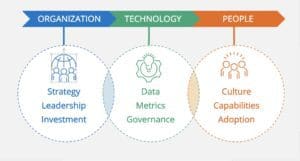Megan Marie Butler, Future of Work Strategist at Rizing, recently discussed the experience of implementing SAP® SuccessFactors® at Rizing with Amy Garden, Rizing’s Head of People.
MMB: Rizing Moves from Foundational to Operational Score
Thank you, Amy, for answering our questions about your experience with implementing SAP SuccessFactors.
For context, you moved the organization from a level 1.6/1.8, a strong Foundational score on Rizing People Analytics Maturity Model (PAMM), to a solid Operational score of 2.48.
The next steps were to maximize the current investment with non-digital initiatives and to continue improving people analytics capabilities among your HR team and senior leadership.
Let’s learn more about how you built a strong data and metrics foundation using SuccessFactors.
MMB: Were the People Analytics Maturity Assessment Results Useful?
You achieved a solid operational score using Rizing’s People Analytics Maturity Assessment (PAMA). Can you tell me how you found the assessment and were the results useful?
AG:
Taking the assessment made me think about people analytics in different ways. Rather than just technology, there were data and insights around our people, culture, and analytics maturity.
The report was very detailed. The categories called out different areas we could improve. It helped frame my thoughts about the next steps on our maturity journey – beyond just investing in new technology.
MMB: Which SuccessFactors Modules Did You Implement?
Rizing implemented nearly all the SuccessFactors modules. Which specific modules did you implement, and how has that process gone?
AG:
We implemented Employee Central (EC) as our first module in 2019. That provided us with immediate benefits regarding reporting and global data capture. Previously we stored data in multiple places, and this was the first time we brought it together.
Then, from 2019 to 2021, we implemented:
- Performance Management and Goals Management
- Recruitment
- Time Tracking
- Compensation
- Learning Management System
- Succession Planning and Career Development
The one module I’d love to add is Onboarding. We have employees in 16 countries, each with its own onboarding process. This module would be invaluable to our new hire process.
We’ve also added Lyra to improve our analytics and Qualtrics to capture employee experience data.
MMB: What Order Did You Implement Them In?
In what order did you implement the modules? Would you recommend that order to clients?
AG:
We implemented modules in the following order:
1. Employee Central
The Employee Central (EC) module was first, and I recommend that because it’s the foundational module.
2. Performance Management and Goals
We then moved on to Performance Management and Goals Management. I recommend implementing this module early because having the whole organization on the same performance and goals system is essential.
3. Recruitment
We then implemented the Recruitment module, which was important because different business regions used different recruitment tools. That prevented us from using one global system for recruiting or data gathering.
4. Compensation
Next was the Compensation module, which improved our annual compensation review process. We previously used spreadsheets, and during a period of rapid growth it became unmanageable to calculate merit and pay increases by hand. The Compensation module let us stop mailing all that highly sensitive data around in spreadsheets.
5. Learning Management System & Time Tracking
The Learning Management System was next, then the Time Tracking module. In hindsight, I would’ve implemented the Time Tracking module at the beginning. However, we were using another tool for time management and weren’t ready to migrate. Performance Management and Goals Management was much easier to implement than other modules as it’s less about data and more about the processes.
MMB: What Implementation Approach Did You Use?
To get everybody onto the same system during implementation, organizations need to choose a big-bang approach or a phased approach.
With the big bang approach, everyone gets switched to the new system overnight. In a phased approach, some parts or layers of the business are slowly moved onto the new system over time.
Which approach would you recommend? And in what situations would you recommend the other approach?
AG:
My preference is a phased approach. This ensures the organization isn’t overwhelmed by new tools or too much change.
Implementation of HRIS modules has a big impact on the HR team involved. If you don’t have a dedicated full-time implementation team, phasing it in can help minimize the project’s impact.
The big bang approach works well when you have a dedicated implementation team and don’t want your HR folks to work in two systems simultaneously.
Regardless of the approach, having a good change management plan and enough internal resources is critical to support the implementation while also delivering your routine HR services. It can be a lot to manage successfully.
MMB: Is the Role of HR Changing?
When talking about these implementations, we always talk about the technology and what changes we are making to it. But we know that social changes are also happening in the organization.
What social changes do you see for HR professionals during these technology implementations? How is it changing the role of HR?
AG:
The Rizing HR team needed to learn about the importance of systems and data in the implementation process. We went from having different spreadsheets to using SuccessFactors as our single source of truth.
But SuccessFactors is only as good as the data you put in. We had to educate our HR members about the importance of keeping the system current.
We also had to ensure our managers and employees knew how to use the system. We had to enable them. And we need to educate new employees continually. This is a vital part of the change management aspect of the project. Many people had the right basic skills. They just needed to understand the technology and be able to use it.
HR also needed to be good coaches, trainers, and enablers for the rest of the business so our employees and managers know how to use the system.
The other impact on our HR team is that everyone now has more access to data and reporting. Being able to extract data and analyze it to guide business decision-making has been an essential skill that the team has developed.
Now that they’ve got access to so much data, they’ve had to learn how to use and interpret it.
MMB: Does Data Have a Different Role Now?
Has the role of data and how we interact with it changed from the days of Excel? Does data play a different role with today’s HR and senior leadership teams?
AG:
We trust the data more now because we have a single source of truth. Even our finance team uses SuccessFactors data as part of personnel cost budgeting. Our leaders can access HR data through self-service dashboards with tools like Qualtrics and Lyra. Leaders are less dependent on HR for reports, as they can review the data themselves.
Data is more meaningful now because everyone has access to it. Our leadership team now expects to access the data themselves rather than waiting for it to be given to them.
MMB:
So the role of data and HR has moved from transactionally entering data into different places to capturing what we need to meaningfully interact and work with the data that the system and processes are capturing for us.
AG:
Yes. The role of data has changed significantly, and people now think about data differently as well. As we enter data into the system, we’re always thinking, how can we get this out? How can we use this?
It’s easier when you have a system that captures it all and then can regurgitate it in a simplified fashion. The focus has changed from keeping up with data entry to knowing the data is always there.
MMB: What SuccessFactors Implementation Challenges Does Rizing Still Face?
What challenges does the team still face in maximizing the benefit from SAP SuccessFactors? How do you go from having data and metrics to connecting them to the actions and making measurable, meaningful, and impactful organizational changes?
AG:
This is a challenge we face at Rizing. One of our following projects is to connect HR data to financial or operational data that isn’t stored in SuccessFactors. This will enable a more predictive reporting model rather than our current descriptive capabilities.
We’ve already successfully used data in products like Qualtrics to identify areas of improvement. The first area we found to improve was onboarding – we had employee experience issues there.
We implemented surveys that check in with new hires at the first week, three months, and six months marks, taking a snapshot of their employee experience. As we implement changes and collect new data, we hope to see improvement trends in the survey results.
MMB:
That sounds now like you’re telling a real story with the data rather than trying to make up a story about some data.
AG:
It helps you see the results in the data rather than guessing why things are how they are. We’re also focusing on benchmarking and improving our understanding of metrics that we report on, like attrition. We want to understand how we compare to other similar organizations.
MMB: What Should HR Leaders Do to Prepare for SuccessFactors?
I’m thinking about HR professionals and leaders who are struggling to figure out how to get better with data and analytics. What recommendations would you make when they are either preparing for or in the process of implementing SuccessFactors?
AG:
Having a roadmap for the project with a vision of the end state is vital to understanding and communicating with your stakeholders. Understanding your stakeholders and how this process will impact them is also critical. Make sure to get everyone involved in the project early on.
For example, we had business representatives and champions on the project team. These team members weren’t involved in the daily meetings, but we included them in demos, discussions about key decisions, and system testing. Their feedback was invaluable and helped design a system that worked for everyone.
The other areas to not forget about are change management during implementation, ongoing support, and training for new employees and managers. It’s essential to identify gaps in the uptake or skills.
For example, when we implemented our recruiting module, we noticed some of our recruiters in some regions weren’t using certain key functions. We could see it in the data and were able to respond with training. Remember that the journey has just started when the implementation is finished.
MMB: Why Should Companies Implement SuccessFactors?
Why should HR professionals want to implement a platform like SAP SuccessFactors? What will change about their role? Is it beneficial?
AG:
Having a system that you can trust, the organization can trust, and that’s easy to use raises the HR profile. Rather than administratively chasing your tail, you can confidently speak to issues with senior management and back them up with data.
It also frees up time from chasing spreadsheets and dreaded situations with problematic data to focusing on important and urgent issues. You can focus on strategic elements of HR rather than spending all of your time on manual data processing.
MMB: Thanks!
Freeing up time from data entry and management to focusing on strategic work sounds like a good reason to use SuccessFactors. Thank you so much for your time – we appreciate your insights!
AG:
Happy to help!
Need Help With SuccessFactors?
If your company needs help from an SAP implementation partner that’s been down the SuccessFactors implementation path already, please contact us.



